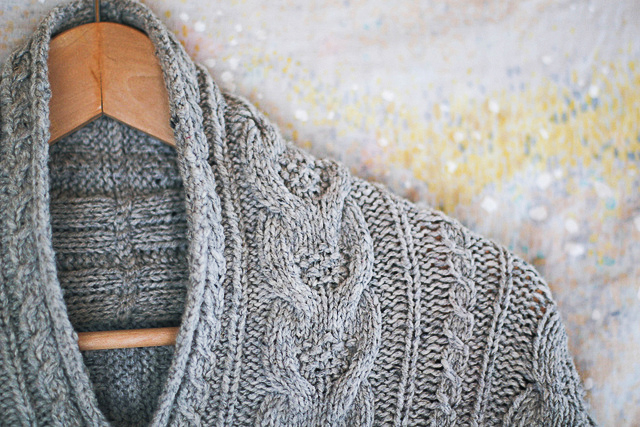










Explore the rich history and learn the how-to of beautiful British fisherman’s knits.
Teacher: Julia Billings
Workshop Duration: Full Day
Description: We’ll begin by delving into the history, regional styles and construction methods of that knitter’s hallowed ground, the fisherman’s jumper, and explore the elements that make it immensely practical and often very beautiful. We’ll take a look at both traditional and contemporary materials and how contemporary taste is altering the original shape, fabric and aesthetic.
After learning to work cables (both with a cable needle and without) and knit/ purl textures, we’ll explore some of the more unusual stitch patterns and tackle the issues and challenges involved in designing with a combination of stitch patterns, putting pencil to paper to come up with personals designs for a shoulder bag.
Materials: Because this class involves combining different stitch patterns to make your own design for a bag, yarn requirements will vary depending on the stitches you use and so can only serve as an estimate. For this reason, I'd recommend using stash yarn that you have plenty of (or are happy to treat as a large sample for the real project if you run out!) or buying more than you may need. Just as a guide for your planning, the use of cables in your design will increase the amount of yarn you will need, while knit-purl combinations will require less.
You will need 550-800m of 8ply or 500-700m of 10ply yarn. Yarn should be made of wool, sturdy enough to prevent the bag from sagging and relatively plain in texture and colour in order to highlight complex stitch patterns. Suggested yarns: Cascade 220, Isager Jensen and Zealana Heron (due to the possum content, this one is suitable for larger patterns such as cables but not for fine knit-purl combinations), all of which are available from Sunspun in Canterbury.
Please also bring a 50-60cm circular needle in the size required to get 23-24st/ 10cm in 8ply or 19-20st/ 10cm in 10ply, as well as one a size smaller, a crochet hook in roughly the same size, a cable needle, stitch markers, a lead pencil, rubber and a few different coloured pencils.
Please contact Jules at jules@woollenflower.com if you need further clarifications on yarn
Takeaway: Students will begin knitting a shoulder bag in class and will take away an understanding of the history and the essential skills involved this style of knitting, as well as comprehensive notes on the techniques and processes.
Level: Advanced Beginner/Intermediate. Prerequisites are casting on and off, knit and purl, increasing and decreasing, reading a knitting pattern.
Explore the rich history and learn the how-to of beautiful British fisherman’s knits.
Teacher: Julia Billings
Workshop Duration: Full Day
Description: We’ll begin by delving into the history, regional styles and construction methods of that knitter’s hallowed ground, the fisherman’s jumper, and explore the elements that make it immensely practical and often very beautiful. We’ll take a look at both traditional and contemporary materials and how contemporary taste is altering the original shape, fabric and aesthetic.
After learning to work cables (both with a cable needle and without) and knit/ purl textures, we’ll explore some of the more unusual stitch patterns and tackle the issues and challenges involved in designing with a combination of stitch patterns, putting pencil to paper to come up with personals designs for a shoulder bag.
Materials: Because this class involves combining different stitch patterns to make your own design for a bag, yarn requirements will vary depending on the stitches you use and so can only serve as an estimate. For this reason, I'd recommend using stash yarn that you have plenty of (or are happy to treat as a large sample for the real project if you run out!) or buying more than you may need. Just as a guide for your planning, the use of cables in your design will increase the amount of yarn you will need, while knit-purl combinations will require less.
You will need 550-800m of 8ply or 500-700m of 10ply yarn. Yarn should be made of wool, sturdy enough to prevent the bag from sagging and relatively plain in texture and colour in order to highlight complex stitch patterns. Suggested yarns: Cascade 220, Isager Jensen and Zealana Heron (due to the possum content, this one is suitable for larger patterns such as cables but not for fine knit-purl combinations), all of which are available from Sunspun in Canterbury.
Please also bring a 50-60cm circular needle in the size required to get 23-24st/ 10cm in 8ply or 19-20st/ 10cm in 10ply, as well as one a size smaller, a crochet hook in roughly the same size, a cable needle, stitch markers, a lead pencil, rubber and a few different coloured pencils.
Please contact Jules at jules@woollenflower.com if you need further clarifications on yarn
Takeaway: Students will begin knitting a shoulder bag in class and will take away an understanding of the history and the essential skills involved this style of knitting, as well as comprehensive notes on the techniques and processes.
Level: Advanced Beginner/Intermediate. Prerequisites are casting on and off, knit and purl, increasing and decreasing, reading a knitting pattern.